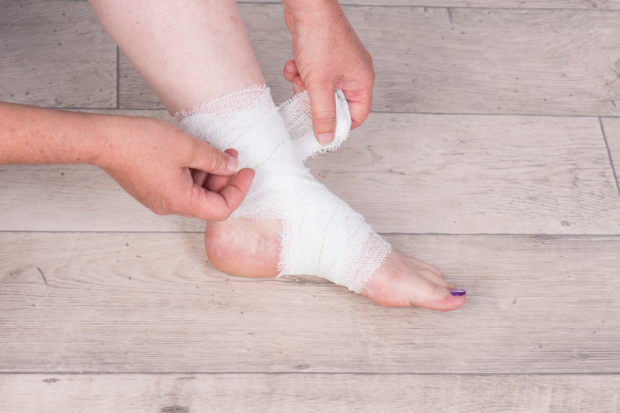Sprain Sprain Go Away How To Treat A Sprained Ankle
Everything you need to know about how to treat a sprained ankle, specific ankle sprain symptoms to look out for, and how long your ankle sprain recovery will take.
Ankle sprains are no laughing matter and land about 25,000 people on the sidelines or in hospitals every day. Knowing how to treat a sprained ankle quickly and correctly can be the difference between a few days or weeks of recovery time versus months or even a lifetime of ankle pain and sprain reoccurrences. Therefore, it’s important to know the proper steps of responding to this all-too-common foot injury.
Symptoms of a Sprained Ankle
A sprained ankle occurs when one or more of the ligaments on the outer side of your ankle are stretched too far or are suddenly torn. When the ankle rolls inward and stretches or tears a ligament, it’s called an inversion sprain, whereas when the ankle rolls outward and stretches and tears a ligament, it’s called an eversion sprain. Both types of ankle sprains can cause swelling and varying degrees of pain ranging from a slight tenderness to intense discomfort that prohibits walking.
A mild sprain can result in symptoms that include swelling, stiffness and tenderness in the ankle. A medium sprain causes symptoms like mild bruising, swelling, stiffness and difficulty walking. And a serious sprain may cause all of the above symptoms as well as instability that makes walking impossible. In most cases, the more pain and swelling that occurs, the worse off the injury and recovery time will be.
A sprain can be difficult to discern from an ankle fracture, so if you’re unable to bear weight on the foot or are experiencing significant swelling or a visual abnormality of the ankle area, you should seek medical treatment from your doctor or an orthopaedist right away.
Immediate Steps To Take If You Sprain Your Ankle
After discerning whether or not you should seek medical attention, the most important thing to do if you suspect you’ve sprained your ankle is to take the RICE approach: Rest, Ice, Compression, Elevation. It is as follows:
- Rest: Immediately take all weight off of the sprained ankle, which may mean having to use crutches in most cases.
- Ice: Use ice packs on the injured ankle for 24 to 72 hours, or until the swelling goes down. Be sure to always keep a thin cloth or towel between your skin and the ice pack to avoid frostbite.
- Compression: Wrap the affected ankle in an ACE bandage or other type of compression wrap to further help reduce swelling and keep your ankle in a secure, brace position.
- Elevation: Try to keep your sprained ankle elevated for at least a few hours a day to help ward off any additional inflammation and bruising.
In addition to calling your doctor for an official examination, you may also want to take over-the-counter pain relievers, such as ibuprofen. Pain and ankle swelling should go down within a couple of days, but you may want to limit physical activity for several weeks in order to give the ligaments in your injured ankle a chance to fully heal. A good rule of thumb to use before resuming regular activity is not to engage in sports or other activities until you can comfortably hop on the injured ankle with no pain.
Long-Term Treatment of Sprained Ankles And Recovery Time
Properly responding to a sprained ankle and giving the affected foot plenty of rest and rehabilitation time is your best bet in preventing long-term ankle issues and ankle sprain reoccurrences. Not giving your ankle proper rehab time means you’re more likely to injure the same ankle again and you could face chronic pain, instability and even arthritis in the ankle joints.
After an initial recovery period that could last a few days up to a few months (depending on the severity of the injury) there are a few remedies and steps you can take to further speed up the sprain healing process and prevent further ankle sprains and injures from occurring in the future.
- One of the most important things you can do once your ankle is recovered is to begin exercises that help strengthen your legs, feet and ankles. This will help with balance as well as getting the tendons, joints and muscles back in normal working order.
- Try to brace your ankle either in a bandage or in a specialty lace-up brace to help protect and stabilize the ankle, especially during physical activity that stresses the ligaments.
- Choose comfortable footwear specifically made for whatever activity you’re engaging in and be sure the shoes you wear are properly fitted to your feet. Additionally, you may want to wear hiking boots or other high-top footwear for a couple of months after your sprain to further help stabilize the ankle.
If you are still experiencing pain and/or instability after several weeks or months of rest and rehab for your sprained ankle, you may need to see a podiatrist or an orthopaedic surgeon about the possibility of ankle surgery to help repair the torn or stretched ligaments.
Now that you know how to treat a sprained ankle, find out why you should avoid certain gym exercises if you frequently wear high heels (finally, an excuse to skip the gym!) and why vibrating insoles may be the next big thing in the athletic world.
Notice concerning medical entries:
Articles having medical content shall serve exclusively for the purpose of general information. Such articles are not suitable for any (self-) diagnosis and treatment of individual illnesses and medical indications. In particular, they cannot substitute for the examination, advice, or treatment by a licensed physician or pharmacist. No replies to any individual questions shall be effected through the articles.







